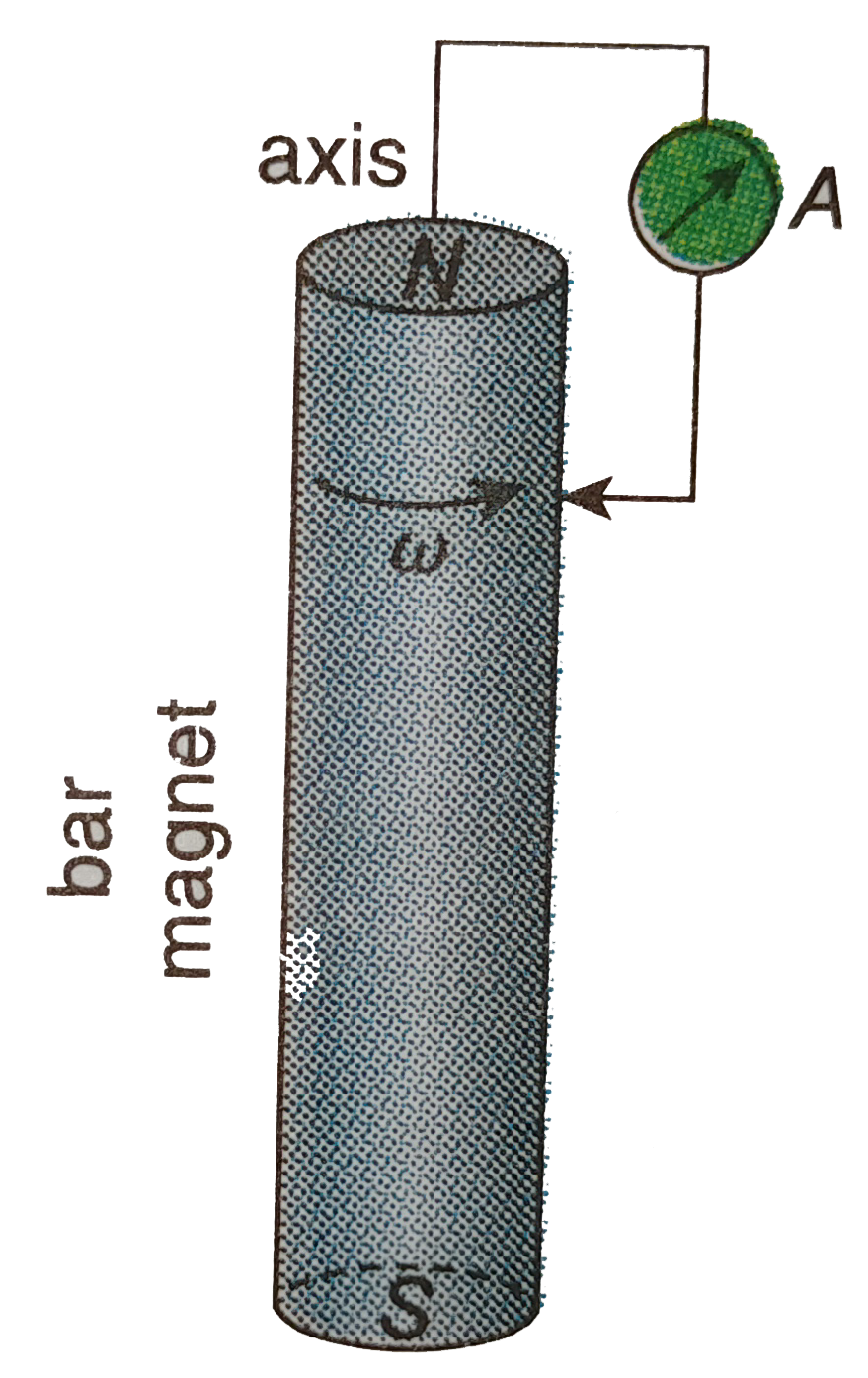A 1.0 m long metallic rod is rotated with an angular velocity of 400 rad. s−1 about an axis normal to the rod passing through its one end. The other end of the rod is in contact with a circular metallic ring. A constant and uniform magnetic field of 0.5 T parallel to the axis exists everywhere. Calculate the emf developed between the centre and the ring. Solution in Bengali
e=Blv2=0.5×1×1×4002=100V
Topper's Solved these Questions
- BOOK - CHHAYA PUBLICATIONCHAPTER - ELECTROMAGNETIC INDUCTION & ALTERNATING CURRENTEXERCISE - NCERT EXEMPLAR QUESTIONS WITH ANSWER HINT (MCQ-1)5videos
ELECTROMAGNETIC INDUCTION & ALTERNATING CURRENT
- BOOK - CHHAYA PUBLICATIONCHAPTER - ELECTROMAGNETIC INDUCTION & ALTERNATING CURRENTEXERCISE - NCERT EXEMPLAR QUESTIONS WITH ANSWER HINT (MCQ-2)4videos
ELECTROMAGNETIC INDUCTION & ALTERNATING CURRENT
- BOOK - CHHAYA PUBLICATIONCHAPTER - ELECTROMAGNETIC INDUCTION & ALTERNATING CURRENTEXERCISE - HOTS19videos
ELECTROMAGNETIC INDUCTION & ALTERNATING CURRENT
- BOOK - CHHAYA PUBLICATIONCHAPTER - ELECTRIC POTENTIAL EXERCISE - CBSE Scanner13videos
ELECTRIC POTENTIAL
- BOOK - CHHAYA PUBLICATIONCHAPTER - ELECTROMAGNETIC WAVES EXERCISE - CBSE SCANNER17videos
ELECTROMAGNETIC WAVES
Similar Questions
A cylinder bar magnet is rotated about its axis. A wire is connected from the axis and is made to touch the cylindrical surface through a contact. Then
 03:21View Solution
03:21View SolutionA metal plate is getting heated. It can be because
06:48View SolutionA cylindrical bar magnet is placed along the axis of a circular coil. If the magnet is rotated about that axis, will any current be induced in the coil?
02:30View SolutionA test charge q is moved without acceleration along the path from A to B from B to C in electric field E as shown in fig.

(i) Calculate the potential difference between A and C.04:42View SolutionWhat are the directions of electric and magnetic field vectors relative to each other and relative to the direction of propagation of electromagnetic waves?
02:05View SolutionA 1m long calculating rod rotates with an angular frequency of 400 rad s−1 an axis normal to the rod passing through its one one end. The other end of the rod is contact with a circular metallic ring. A constant magnetic field of 0.5 T parallel to the axis everywhere. Calculate the e.m.f. developed between the centre and the ring.
02:58View SolutionA 2 m long metallic rod rotates with an angular frequency 200" rod "s^(-1) about on axis normal to the rod passing through its one end. The other end of the rod is in contact with a circular metallic ring. A constant megnetic field of 0.5 T parallel to axis exises everywhere. The emf developed between the centre and the ring is
03:48View SolutionA 1.0 m long metallic rod is rotated with an angular frequency of 400rad s−1 about an axis normal to the rod passing through its one end. The other end of the rod is in contact with a circular metallic ring. A constant and uniform magnetic field of 0.5 T parallel to the axis exists everywhere. Calculate the emf developed between the centre and the ring.
02:13View Solution1.0 मीटर लम्बी धातु की छड़ उसके एक सिरे से जाने वाले अभिलंबवत अक्ष के परितः 1400rads−1 की कोणीय आवृति से घूर्णन कर रही है छड़ का दूसरा सिरा एक धात्विक वलय से संपर्कित है । अक्ष के अनुदिश सभी जगह 0.5T का एकसमान चुम्बकीय क्षेत्र उपस्थित है । वलय तथा अक्ष के बीच स्थापित विद्युत वाहक बल की गणना कीजिये ।
01:20View Solution1.0 m लंबी धातु की छड़ उसके एक सिरे से जाने वाले अभिलंबवत अक्ष के परितः 400rads^(-1)की कोणीय आवृत्ति से घूर्णन कर रही है। छड़ का दूसरा सिरा एक धात्विक वलय से संपर्कित है। अक्ष के अनुदिश सभी जगह 0.5 T का एकसमान चुंबकीय क्षेत्र उपस्थित है। वलय तथा अक्ष के बीच स्थापित विद्युत वाहक बल की गणना कीजिए।
03:24View SolutionA 1.0 m long metallic rod is rotated with an angular frequency of 400 rad s^(-1) about an axis normal to the rod passing through its one end. The other end of the rod is in contact with a circular metallic ring. A constant and uniform magnetic field of 0.5 T parallel to the axis exists everywhere. Calculate the emf developed between the centre and the ring.
View SolutionA 1.0 m long metallic rod is rotated with an angular frequency of 400 rad s−1 about an axis normal to the rod passing through its one end. The other end of the rod is in contact with a circular metallic ring. A constant and uniform magnetic field of 0.5 T parallel to the axis exists everywhere. Calculate the emf developed between the centre and the ring.
View SolutionA 1m long calculating rod rotates with an angular frequency of 400 rad s^(-1) an axis normal to the rod passing through its one one end. The other end of the rod is contact with a circular metallic ring. A constant magnetic field of 0.5 T parallel to the axis everywhere. Calculate the e.m.f. developed between the centre and the ring.
03:04View SolutionA 1.0 m long metallic rod is rotated with an angular frequency of 400 rad s−1 about an axis normal to the rod passing through its one end. The other end of the rod is in contact with a circular metallic ring. A constant and uniform magnetic field of 0.5 T parallel to the axis exists everywhere. Calculate the emf developed between the centre and the ring.
03:07View SolutionA 2 m long metallic rod rotates with an angular frequency 200 rod s−1 about on axis normal to the rod passing through its one end. The other end of the rod is in contact with a circular metallic ring. A constant megnetic field of 0.5 T parallel to axis exises everywhere. The emf developed between the centre and the ring is
01:08View Solution

